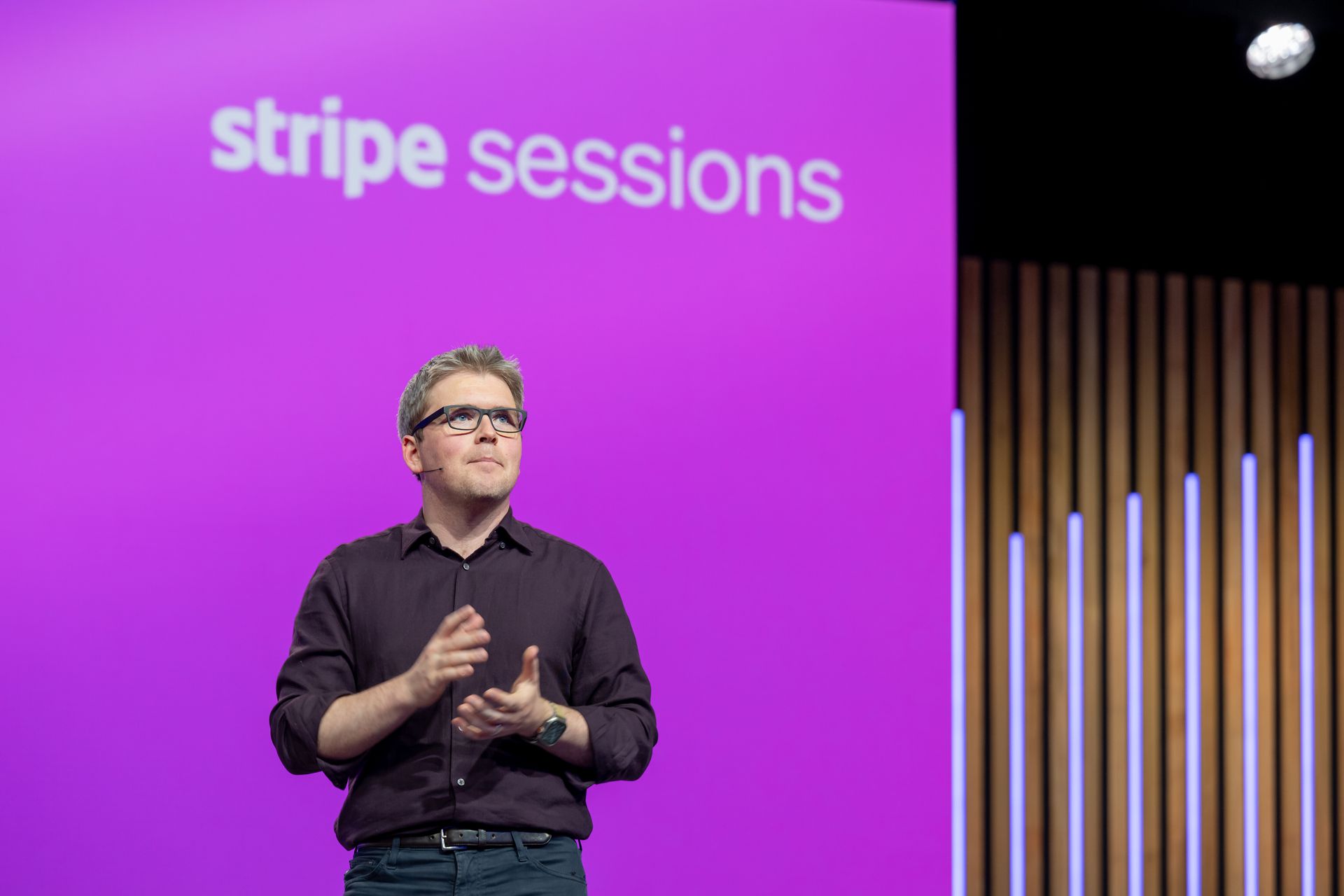
John Collison on stage at Stripe’s annual user conference. Courtesy of Stripe
Well, here we go.
It’s been about 24 hours since I announced across my networks that I’ve left the safety of a “Big Media” gig at Fortune to launch this newsletter about AI’s impact on commerce. And I’m still feeling so much gratitude for the initial response. So thank you. Truly. This is of course just the very beginning, but your early support has me convinced that I’m onto something and that the future of The Aisle might just turn out as bright as I imagined.
Now before we get to the inaugural edition, a fascinating conversation with Stripe cofounder John Collison, some necessary housekeeping: If you’re reading this, you’ve likely signed up for a subscription to The Aisle. And if you want to make sure this reaches you in your main inbox, and not Spam or a Promotions tab, I have two quick requests:
Move this email to your main inbox if it’s not there already.
Reply back to me with a couple of words about why you subscribed, or what you want me to cover, or your hottest AI commerce take. Or ask me anything. It’ll be a signal to the email gods that you want to keep receiving The Aisle and I really want to make those gods happy. They can be vicious. Plus, I’ll respond to every one.
Lastly, I want to be upfront that you'll need a paid membership to read the vast majority of the work I produce. Free subscribers will still get snippets of each of my newsletters, including on this one, but only occasionally more than that. I’ve launched this venture in part because I believe my work, expertise, and ideas are worth paying for and will help you do your job better at best, and educate or entertain you at worst. I hope, if you aren’t yet sure of that, that I’ll convince you quickly.
Of course, you can also upgrade to a paid subscription right now to get access to everything I produce plus some pretty cool perks. The signup should take all of 30 seconds: https://www.readtheaisle.com/join.
I lied. One more thing. Each week, I’m hoping to spotlight a cool AI use case discovered or practiced by a member of The Aisle family. Next week’s is a fascinating one that features a former Amazon executive, WWII military service records, and a once-in-a-lifetime vacation only made possible by an LLM. Send me yours. And send me story tips. Please.
Now onto my conversation with Stripe’s John Collison in the main section of the weekly newsletter that I’ll be calling….drumroll…The Center Aisle. Please do let me know what you think.
The Center Aisle
I first met John Collison around 2013 or 2014 when I was just starting to cover the e-commerce and online payment industries. I was working either at Recode or its predecessor AllThingsD (yes, youngins, that was actually the publication’s name; the D stood for…Digital). RIP to both websites. I still miss them.
Collison, who cofounded the payments company Stripe with his older brother Patrick in 2010, was probably only 23 or 24 at the time. And yet it was immediately clear why Silicon Valley investors were falling over themselves to back his company: yes, his startup was making it dead-simple for companies big and small to start accepting online payments, but he could also zoom into the technical details one second, and zoom out to tell the big-picture vision of online commerce’s future in the next.
A decade later, Stripe is worth some $106 billion and finds itself at the center of the emerging AI-powered commerce, or agentic commerce, space. (We can debate all of this terminology at some point soon.) The company announced in late September that it was partnering with OpenAI to develop an open standard (called the Agentic Commerce Protocol) to make it easy and secure for people to buy products directly through a ChatGPT chat. Early partners include Etsy, Shopify, and Walmart.
I caught up with Collison recently to discuss this partnership, AI’s impact on the upcoming holiday season, and what he would do if he was suddenly thrust into the role of Amazon CEO. Plus a whole lot more.
I’ve lightly edited and condensed our chat for clarity.
So I'm going to try to cover a lot of ground here, but I appreciate you doing this. It's a big leap for me, and I'm glad that you're willing to chat.
John Collison: So you are launching a newsletter devoted to agentic commerce?
A newsletter, plus, eventually, more. But yes, an independent media company focused on “agentic commerce,” although that's one of my first questions: What is the umbrella term? I know we've gravitated toward “agentic commerce,” but “AI-powered” kind of feels more accurate. Or “AI-led”? I saw that one in your press release. Then there's the old school “conversational commerce.” Where do you stand on the terminology?
JC: I think you're right that the term “agentic commerce” includes a lot of different things the way it’s being used, but what is actually happening today and working is a form of conversational commerce — I don’t even know if conversation is the right word actually, because often it's in a nicely presented UI that you just click through. But being able to buy in ChatGPT; that is just a great experience. It is working.
You remember…back in the day Instagram commerce and Twitter commerce? I think basically those were a good idea of off-site commerce that didn't have enough pull from merchants. Whereas here, if you've had the experience of doing product research in ChatGPT or an AI tool like it, it's a really good experience. And therefore this is already seeing much more merchant interest and much more kind of real-world success than that other stuff.
Then there's agentic commerce (meaning an AI bot or agent is making a purchase without human supervision). The example that people always pitch is this heavily unsupervised use case like, “I'm going on a honeymoon next month, please research and book a whole bunch of stuff in Japan for me and my wife to do.” And I think obviously this highly unsupervised stuff is more interesting to talk about and will happen over time, but there will still be a [major] transformation in AI-enabled commerce even when a human is still involved.
Yeah, these use cases are still really powerful. For example, and I won't admit this to my wife that I just bought her Halloween-themed cheese board—two things she loves for her day-before-Halloween birthday—via recommendations from Perplexity. Actually, I forget which AI tool. Maybe that's a problem that I don't remember which AI tool I used.
So let’s talk about what you’ve already announced with OpenAI for those who maybe didn't see it or just saw the headline. Can you explain it?
JC: So discovery is happening on the AI apps within consumer shopping. A lot of product research and product discovery happens there. And so the launch example we had was Etsy. The thing we showed was searching for a Halloween costume for your daughter. “She's into these kinds of things. Please find me something nice.” And previously, the AI would have essentially said, “Here's a bunch of links. Go buy them if you want. Good luck.” And then you'd have to do another five or 10 minutes more work.
And so the experience we launched with ChatGPT—and the initial launch partners were Etsy and Shopify—was that you can hit Buy directly in the ChatGPT app. You never have to go off site.
What’s required for that to happen is Stripe acting as the infrastructure between AI apps. It’s ChatGPT now…we’re in discussions with a whole bunch of them.
So AI apps on one side, and merchants like Etsy and Shopify and Walmart and all these merchants on the other side. Merchants publish their product data to the AI apps, and then the AI apps submit orders directly to the merchants. And then Stripe sits in the middle, both handling that data transfer, but also making the payment secure, because you don't want to be flinging your credit card data all around the internet.

Subscribe to The Aisle to read the rest.
Become a paying subscriber of The Aisle to get access to this post and all my work. Plus some perks.

